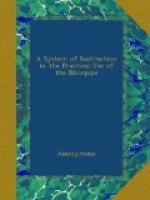([beta].) Oxide of Silver (AgO).—It is a greyish-brown or black powder, and is the base of the silver salts. With aqua ammonia, it is converted into the black, fulminating silver.
([gamma].) Superoxide or Binoxide of Silver (AgO^{2}).—This oxide occurs in black needles or octahedral crystals of great metallic lustre. It is dissolved by the oxygen acids with the disengagement of oxygen gas.
Behavior before the Blowpipe.—When exposed to the flames of oxidation and reduction, the oxides of silver are instantly reduced to the metallic state.
Borax dissolves silver-oxides upon platinum wire in the oxidation flame but partially, while the other portion is reduced, the bead appearing opalescent after cooling, in correspondence to the degree of saturation. The bead becomes grey in the flame of reduction, the reduced silver melting to a grain, and the bead is rendered clear and colorless again.
Microcosmic Salt dissolves oxides of silver in the flame of oxidation upon platinum wire to a transparent yellowish bead, which presents, when much of the oxide is present, an opalescent appearance.
In the flame of reduction, the reaction is analogous to that of borax.
By fusion with carbonate of soda in the oxidation and reduction flames, the silver oxides are instantly reduced to metallic silver, which fuses into one or more grains.
(c.) Gold (Au).—This metal occurs mostly in the metallic state, but frequently mixed with ores, and with other metals. Gold crystallizes in cubes and octahedrons, is of a beautiful yellow color, great lustre, and is the most malleable and ductile of all the metals. It melts at a higher temperature than copper, gives a green colored light when fused, and contracts greatly when cooling. It does not oxidize at ordinary temperatures, nor when heated much above them. It is soluble in nitro-hydrochloric acid (aqua regia).
([chi].) Protoxide of Gold (Au^{2}O).—This oxide is a dark violet colored powder which is converted by a temperature of 540 deg. into metallic gold and oxygen. It is only soluble in aqua regia. Treated with hydrochloric acid, it yields the chloride of gold and the metal. With aqua ammonia, it yields the fulminating gold, which is a blue mass and very explosive.
([chi].) Peroxide of Gold (Au^{2}O^{3}).—This oxide is an olive-green or dark brown powder, containing variable quantities of water. Decomposed at 530 deg., it yields metallic gold and oxygen.
Reactions before the Blowpipe.—Oxides of gold are reduced, in both the oxidation and reduction flames, to the metal, which fuses to grains.
Borax does not dissolve it, but it is reduced to the metallic state in this flux in either flame. The reduced metal fuses upon charcoal to a grain.
Microcosmic Salt presents the same reactions as borax.




